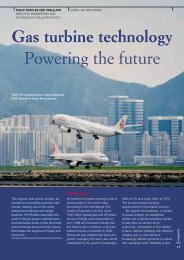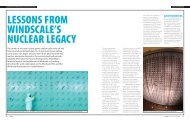Engineering ethics Engineering ethics - Ingenia
Engineering ethics Engineering ethics - Ingenia
Engineering ethics Engineering ethics - Ingenia
You also want an ePaper? Increase the reach of your titles
YUMPU automatically turns print PDFs into web optimized ePapers that Google loves.
PROFESSIONAL ISSUES<br />
considered action, appropriate remedial<br />
steps were taken in time to avert<br />
disaster. The papers contain other<br />
examples of warnings delivered, but<br />
acted on too late, including the case of<br />
High Alumina Cement (HAC) on which<br />
Professor A.M. Neville CBE FREng had<br />
given clear published warnings in the<br />
1960s. Despite this, a series of<br />
collapses in the 1970s still took the<br />
industry and the public by surprise.<br />
The issue of warning of preventable<br />
disasters has also been considered by<br />
the Standing Committee on Structural<br />
Safety (SCOSS). 10 The 13th Report of<br />
SCOSS issued in May 2001 includes a<br />
section on duties to warn and to heed<br />
warnings, which are to be regarded as<br />
essential elements in ensuring structural<br />
safety. The Royal Academy of<br />
<strong>Engineering</strong> Draft Guidelines for<br />
warnings of preventable disasters are<br />
endorsed by the SCOSS report, which<br />
discusses three types of situation in<br />
which professional engineers can find<br />
themselves under a duty to warn or to<br />
heed warnings. These are:<br />
1 when the engineer is part of a group<br />
of professionals, where warnings<br />
should be given to the group;<br />
2 when the engineer has direct<br />
responsibility for the relevant work,<br />
either by checking or certifying the<br />
design or construction or monitoring<br />
the structure;<br />
3 in more complex situations such as<br />
where a warning has been given to<br />
an appropriate person but is being<br />
ignored; where the control of the<br />
unsafe structure is out of the<br />
engineer’s direct responsibility;<br />
where the engineer is a member of<br />
the public; or where an unsafe<br />
situation has passed but could recur<br />
or arise elsewhere.<br />
It is emphasised that in all these<br />
situations the engineer must deal with<br />
each of the questions:<br />
●<br />
●<br />
●<br />
●<br />
whether to warn<br />
when to warn<br />
who to warn<br />
how to warn.<br />
The report points out that there is a<br />
corresponding duty on persons to heed<br />
warnings both in the immediate and in<br />
the long term, and also to consider the<br />
significance of warning in relation to<br />
other projects. The question of warning<br />
of preventable disasters gives rise to<br />
many further issues, some of which are<br />
now considered.<br />
Consequences of<br />
unauthorised disclosure<br />
If an engineer takes it upon him- or<br />
herself to deliver a warning to the public<br />
in relation to issues of safety or<br />
environment, they expose themselves to<br />
personal risks beyond the threat of legal<br />
proceedings.The actions by engineers in<br />
such circumstances have given rise to<br />
major activity in the field of engineering<br />
<strong>ethics</strong> in the USA. There are many<br />
reported cases of engineers acting in a<br />
responsible manner, assuming the<br />
existence of a duty to warn members of<br />
the public, and of suffering personal<br />
hardship in consequence, frequently<br />
through being victimised as<br />
‘whistleblowers’. While extensive state<br />
and federal legislation exists in the<br />
USA, 11 publications on ethical issues<br />
report numerous cases of hardship<br />
following loss of employment and other<br />
forms of victimisation. It is abundantly<br />
clear from the American experience that<br />
engineers acting in pursuit of a<br />
supposed public duty are not<br />
necessarily perceived as heroes and<br />
there seem few instances of appropriate<br />
recognition being accorded to them. 12<br />
In England relief is now available in<br />
such circumstances through the Public<br />
Interest Disclosure Act 1998. 13 The Act<br />
prohibits dismissal in relation to certain<br />
disclosures defined as ‘qualifying<br />
disclosures’. These include information<br />
which, in the reasonable belief of the<br />
employee, tends to show one or more<br />
of the following:<br />
1 that a criminal offence is being<br />
committed<br />
2 that a person is failing to comply<br />
with a legal obligation<br />
3 that a miscarriage of justice is<br />
occurring<br />
4 that the health or safety of an<br />
individual is being endangered<br />
5 that the environment is being<br />
damaged<br />
6 that information is being concealed.<br />
A qualifying disclosure is a ‘protected<br />
disclosure’ when made in accordance<br />
with the procedure under the Act. In<br />
most cases the employee is obliged to<br />
go first to his employer but in some<br />
circumstances may go over his head.<br />
These include where the worker<br />
reasonably believes he will suffer a<br />
detriment if he goes to the employer or<br />
that evidence will be concealed. Going<br />
direct to the public might also be<br />
justified where the matter is of an<br />
exceptionally serious nature. Where a<br />
disclosure is protected the employer is<br />
prohibited from subjecting the<br />
employee to detriment, dismissing him<br />
or making him redundant on the<br />
grounds of the disclosure. The Act<br />
follows experience in the USA which, as<br />
noted above, has not been wholly<br />
successful in preventing victimisation of<br />
‘whistleblowers’. The effect of the<br />
English Act remains to be established.<br />
Other means of securing<br />
disclosure<br />
The importance of disclosure, and the<br />
adverse consequences which may flow,<br />
dictate that all other avenues should be<br />
explored to find more satisfactory<br />
means of passing on significant<br />
information. The most useful<br />
procedures presently available take the<br />
form of limited confidential reporting<br />
systems. Such reporting does not<br />
guarantee either publicity or action, but<br />
does have the advantage of informality<br />
and avoids accusations of disloyalty.<br />
The 13th Report of SCOSS noted the<br />
existence of proposals for a confidential<br />
reporting system for the construction<br />
industry and that such systems had<br />
been developed in other sectors,<br />
particularly in air transport 14 and in<br />
shipping. 15 A confidential reporting<br />
ingenia<br />
49



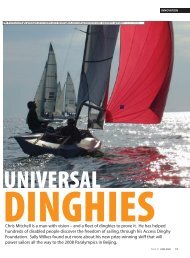

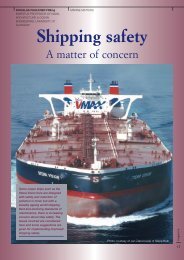


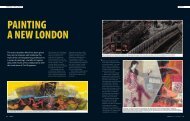
![[322/03] Francke - Ingenia](https://img.yumpu.com/23411337/1/184x260/322-03-francke-ingenia.jpg?quality=85)



